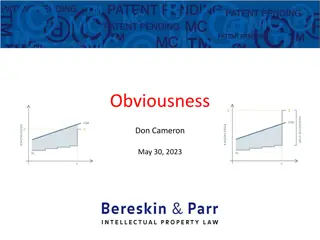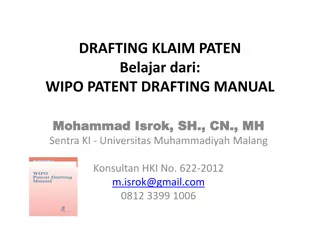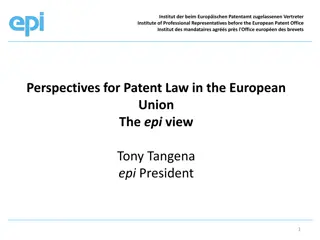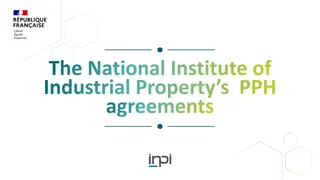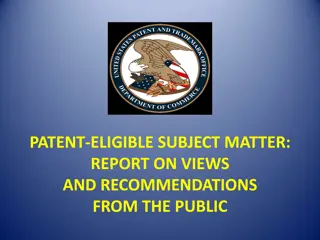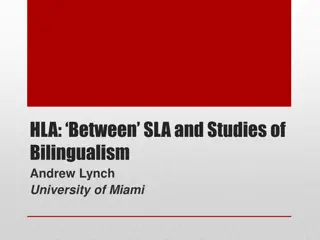Strategic Patent Acquisition in Fragmented Technology Markets
This article explores how firms adopt aggressive patenting strategies to avoid being constrained by technology owners. It delves into the complexities of hold-up problems in technology markets and the challenges firms face in acquiring patents to secure their position. The discussion encompasses scenarios where firms must navigate through a multitude of patents held by various owners, emphasizing the strategic decisions involved in licensing negotiations and potential alternatives to address patent-related issues.
Uploaded on Sep 09, 2024 | 1 Views
Download Presentation

Please find below an Image/Link to download the presentation.
The content on the website is provided AS IS for your information and personal use only. It may not be sold, licensed, or shared on other websites without obtaining consent from the author.If you encounter any issues during the download, it is possible that the publisher has removed the file from their server.
You are allowed to download the files provided on this website for personal or commercial use, subject to the condition that they are used lawfully. All files are the property of their respective owners.
The content on the website is provided AS IS for your information and personal use only. It may not be sold, licensed, or shared on other websites without obtaining consent from the author.
E N D
Presentation Transcript
Dont Fence Me In: Don t Fence Me In: Fragmented Markets for Fragmented Markets for Technology and the Patent Technology and the Patent Acquisition Strategies of Firms Acquisition Strategies of Firms Rosemarie Ham Ziedonis (2004) Management Science Presented by Der-Ting Huang
Introduction Introduction Research Gap: Although characteristics of firms and their external environments have been highlighted in the theoretical literature, prior research has not explored the extent to which such factors interact to shape the patenting behavior of firms Main Purposes: This article examines the conditions under which an aggressive patenting strategy is an alternative mechanism that firms use to avoid being fenced in by owners of technologies used, perhaps unknowingly, in the design and manufacture of their products. Combine the insights from both transaction cost economics (TCE) and intellectual property (IP)
Theory and Hypotheses Theory and Hypotheses Hold-up in Markets for Technology Hold-up problem: A situation where two parties may be able to work most efficiently by cooperating but refrain from doing so because of concerns that one party may expropriate economic rents from another. Public-goods nature of IP complicates the traditional hold-up problem Patent is an exclusionary right, not an affirmative right. Facing a make-and-buy decision attention paid to the price a firm expects to pay in the event it needs to purchase legal rights to use technologies patented by others and ways to improve its ex post bargaining position A firm s bargaining challenge is affected by the level of dispersion among rights holders not just by the number of patents in a thicket or the number of owners per se an anti-commons problem
Theory and Hypotheses Theory and Hypotheses Hold-up in Markets for Technology Dispersion level among rights holders Example: A semiconductor manufacturer deciding to invest $1 billion in a new fabrication facility. Assume the firm has identified 1,000 patents it believes might be infringed on in the design or manufacture of its products. However, the firm is still unsure whether these patents are valid and, if so, the effective scope of their claims. Should the firm negotiate rights to use these technologies with their respective patent owners prior to building the facility? Scenario 1: the 1,000 patents are all assigned to one firm Scenario 2: the 1000 patents are assigned to 1,000 different entities (1) contact the patent owner to secure a license or an alternative contractual arrangement before investing in the facility (2) choose to invent around the patents (if possible). (3) License negotiation: reduce the per-patent cost of valuing the rights by restricting attention to the most valuable inventions Reliance on ex ante solutions infeasible for the firm (1) seek a right to use the patented technologies from each owner, BUT with a more careful examination of whether patents are valid and possibility of getting excluded from using the invention ex post (2) Unlikely to spread the valuation costs across individual owners due to context-specific nature of the asset The distributional characteristic of the firm s external market for technology has important implications for the costs and potential delays associated with ex ante solutions.
Theory and Hypotheses Theory and Hypotheses Implications for Patent Acquisition Strategies Key factors affecting a firm s risk of patent-related expropriation and feasibility of ex ante contracting Expropriation risks are higher for firms with assets that are costly to redeploy to alternative uses or users Ex ante contractual solutions are more costly (less feasible) for firms that draw on fragmented pools of external technologies. Contractual dilemmas underinvestment in innovation Mitigation of expropriation risk in markets for technology To acquire owners of the patents: direct costs of the acquisition and indirect costs related to diminished flexibility and unrealized gains from trade with specialized firms To amass larger patent portfolios of their own in order to improve ex post bargaining positions Hypothesis 1: The more fragmented the external technology markets, the more aggressively firms will patent (beyond what is otherwise predicted).
Theory and Hypotheses Theory and Hypotheses Implications for Patent Acquisition Strategies Aggressive acquisition strategy is important when: External technology markets are highly fragmented The anticipated cost associated with being held up is large Semiconductor industry: large sunk investments in manufacturing facilities Complexity Interrelatedness (state-of-the-art facilities) Investment decisions made years prior to a new product invention Rapid depreciation Hypothesis 2: The effect of fragmented external rights on incentives to patent will be more pronounced among capital-intensive firms (all else equal).
Theory and Hypotheses Theory and Hypotheses Implications for Patent Acquisition Strategies The role of laws in governing the strength and enforceability of patent rights The U.S. legal environment during the 1980s effectively strengthened the rights of patent owners in the United States Economic incentives of patent owners to enforce their rights Incentives of firms to avoid being held up Impact of disperse outside patent rights on firm patenting behavior will be amplified Hypothesis 3a: The effect of fragmented external rights on incentives to patent will be stronger following the pro-patent shift in the U.S. legal environment (all else equal). Hypothesis 3b. The interaction effect between fragmented rights and capital-intensity will be greater in magnitude following the pro-patent shift in the U.S. legal environment (all else equal).
Method Method Fragmentation index 2 ????????? ???????? ? ?????= 1 ?=1 patents issued to firm ? (the number of back-ward citations) in a given year and ???????? is the total number of citations listed in patents assigned to each firm on an annual basis Normalized index: ??= ???????? 1 Sample A total of 67 U.S. firms in the semiconductor-related industry (SIC 3674) during the 1980- 1994 period, generating 667 observations. , where ? refers to each unique entity that is cited by ???????? ?????
Method Method Variables Dependent variable: the number of successful patent applications made by a firm in a given year Independent variables: fragmentation index (FRAG), a dummy FRAG, an interaction term between FRAG and capital-intensity, and legal environment Control variables: firm size, R&D spending, capital-intensity, Texas Instruments, annual time dummies Model Specification Negative binomial specification (generalization of the Poisson model) ? ??? ??? = ???= exp(???? + ??), where i indexes the firm and t indexes the year. ??is an overall year-specific mean that measures the average patenting across all firms, adjusting for the changing mix of firms in the sample
H2 H1 Results H3 * * < 0.69=2.138-1.444
Conclusion Conclusion Conclusion Finds that firms acquire patents more aggressively than otherwise predicted when markets for technological inputs are highly fragmented. Moreover, this effect is noticeably more pronounced among firms with large investments in technology-specific assets and under a legal regime of strengthened exclusionary rights for patent owners. Contribution Helps bridge a divide in the theoretical literature by (1) isolating two dimensions of a firm s contracting problem in markets for technology and (2) showing how firm-specific and environmental factors interact to shape incentives to patent. Highlights the conditions under which firms amass portfolios of patents as an alternative organizational response. Represents the first large-scale empirical study of fragmentation in technology markets
Discussion Question Discussion Question This article suggests that a firm will acquire patents to avoid being fenced in by outside owners of technology. However, patenting also implies that the firm publishes its technological information, which enables competitors to learn the firm s technology that can be used for related innovation and may block the firm as well. In other words, to avoid being fenced in through patenting may also stirs up more potential fenced in situations. How could the firm deal with this paradox?




